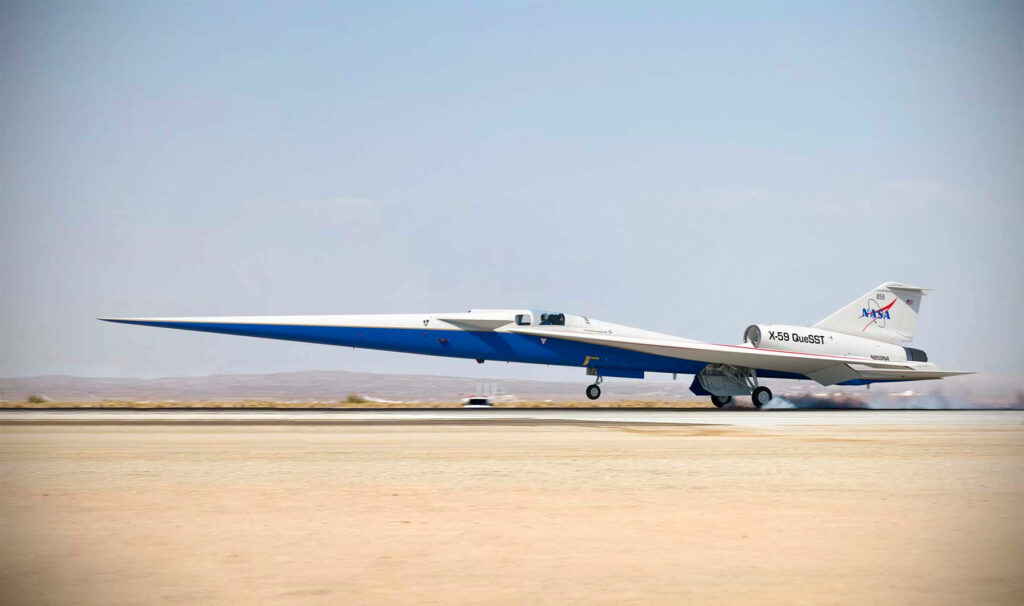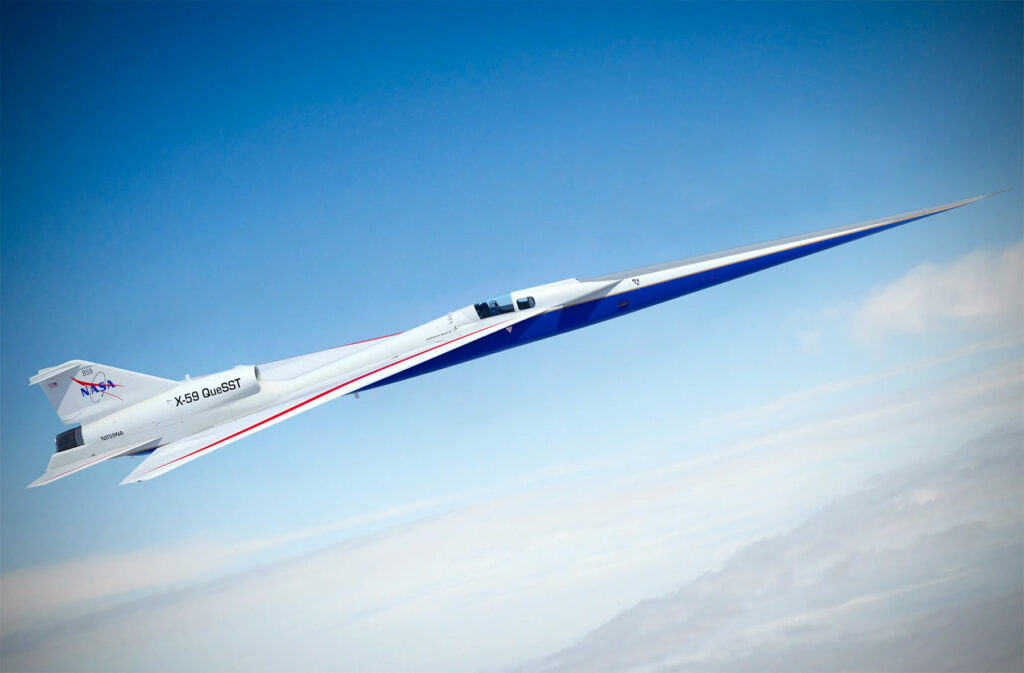Experimental supersonic aircraft designed to reduce sonic boom noise, aiming for quiet overland flight; features innovative aerodynamics and advanced technologies.
The Lockheed Martin X-59 QueSST is an experimental supersonic aircraft developed in collaboration with NASA’s Low-Boom Flight Demonstrator project. Measuring 99.7 feet (30.4 meters) in length with a wingspan of 29.5 feet (9 meters), it is powered by a General Electric F414-GE-100 engine, producing 22,000 pounds-force (98 kN) of thrust. Designed to cruise at Mach 1.4 (925 mph or 1,488 km/h) at an altitude of 55,000 feet (16,764 meters), the X-59 aims to reduce the traditional sonic boom to a 75 Perceived Level decibel (PLdB) “thump”, comparable to the sound of a car door closing. This reduction is achieved through its elongated nose and optimized airframe, which prevent shockwaves from merging. The aircraft features an eXternal Vision System (XVS), utilizing cameras and displays to compensate for the lack of a forward-facing window, ensuring pilot visibility. The X-59’s primary mission is to collect data on community responses to its low-noise supersonic flight, potentially paving the way for future commercial supersonic travel over land. (nasa.gov)
History of the Development of the Lockheed Martin / NASA X-59 LBFD
In the early 21st century, the aviation industry faced a significant challenge: the prohibitive noise of sonic booms, which led to stringent regulations against supersonic flight over land. This limitation hindered the development of faster commercial air travel. Recognizing the need for a solution, NASA initiated the Low-Boom Flight Demonstrator (LBFD) project, aiming to create an aircraft capable of supersonic speeds with minimal noise impact on the ground.
In February 2016, NASA awarded Lockheed Martin’s Skunk Works division a preliminary design contract to develop a supersonic aircraft with reduced sonic boom characteristics. The goal was to design an aircraft that could fly faster than the speed of sound while producing a sonic boom no louder than a gentle thump. This initiative sought to gather data that could potentially lead to the revision of existing regulations, thereby enabling commercial supersonic travel over land.
By April 2018, NASA awarded Lockheed Martin a $247.5 million contract to finalize the design and build the X-59 QueSST (Quiet SuperSonic Technology) aircraft. The project’s objectives were twofold: first, to demonstrate that the aircraft could achieve supersonic speeds with a significantly reduced sonic boom; and second, to conduct community overflight tests to assess public perception of the reduced noise levels.
The design phase involved extensive wind tunnel testing and simulations to refine the aircraft’s aerodynamics. A 9%-scale model underwent wind tunnel tests from February to April 2017, covering speeds from Mach 0.3 to Mach 1.6. These tests aimed to validate the design’s ability to minimize shockwave coalescence, a key factor in reducing sonic boom intensity.
In June 2018, the U.S. Air Force assigned the X-59 designation to the aircraft, marking its official entry into the lineage of experimental X-planes. By October 2018, NASA’s Langley Research Center completed additional wind tunnel testing using an 8%-scale model, focusing on static stability, control, and dynamic forced oscillations. These tests provided critical data to ensure the aircraft’s performance and safety during supersonic flight.
Construction of the X-59 progressed steadily at Lockheed Martin’s Skunk Works facility in Palmdale, California. By December 2020, the project reached the halfway mark, with major structural components coming together. The assembly process involved integrating various subsystems, including the propulsion system, avionics, and the innovative eXternal Vision System (XVS), which compensates for the aircraft’s elongated nose that obstructs a traditional forward cockpit view.
The X-59’s first flight was initially planned for 2021 but faced delays due to technical challenges and the need for thorough testing. As of January 2024, the aircraft was slated for delivery to NASA for flight testing later that year. The flight test program aims to validate the aircraft’s performance, focusing on its low-boom characteristics and overall flight dynamics.
A significant aspect of the X-59 program involves community overflight tests. NASA plans to fly the aircraft over select U.S. communities to gather data on public perception of the reduced sonic boom, referred to as a “sonic thump.” This data will be crucial in informing regulators, such as the Federal Aviation Administration (FAA) and the International Civil Aviation Organization (ICAO), potentially leading to new standards that allow commercial supersonic flight over land.
The development of the X-59 QueSST reflects a concerted effort to overcome the historical challenges associated with supersonic flight. By addressing the noise issue, the project aims to pave the way for a new era of faster air travel, making supersonic flight more practical and acceptable for widespread use.

Design of the Lockheed Martin / NASA X-59 LBFD
The X-59 QueSST was designed to address the primary issue of supersonic travel over land: the disruptive sonic boom. Traditional supersonic aircraft, such as the Concorde, produced a loud, disruptive boom due to the coalescence of shockwaves along the fuselage. The X-59’s unique aerodynamic shape prevents these shockwaves from merging, significantly reducing the noise perceived on the ground.
Airframe and Aerodynamics
The X-59 measures 99.7 feet (30.4 meters) in length with a relatively narrow wingspan of 29.5 feet (9 meters). The aircraft’s fuselage is elongated and slender, with a nose extending 38 feet (11.5 meters). This long, pointed nose diffuses the pressure waves, ensuring that instead of a sharp sonic boom, only a softer “thump” reaches the ground.
The aircraft’s canard configuration improves longitudinal stability, while the highly swept delta wing minimizes drag at high speeds. Unlike traditional supersonic aircraft, the X-59 does not rely on a traditional cockpit-forward design. Instead, it utilizes an eXternal Vision System (XVS), which replaces a conventional forward-facing windshield with high-definition cameras and an augmented reality display. This system compensates for the obstructed forward view caused by the elongated nose.
Materials and Structural Composition
The airframe is constructed from advanced composite materials, primarily carbon fiber-reinforced polymers (CFRP), reducing overall weight while maintaining strength. The fuselage also incorporates titanium in high-temperature areas, particularly near the engine, to withstand the heat generated at supersonic speeds.
The wings are made from a combination of aluminum and composite materials, designed to withstand the aerodynamic stresses of supersonic flight. The use of laminar flow control ensures that air moves smoothly over the wing surfaces, reducing drag and improving fuel efficiency.
Engine Integration and Air Intake
The X-59 is powered by a single General Electric F414-GE-100 turbofan engine, mounted on top of the fuselage to shield ground observers from engine noise. This positioning minimizes the aircraft’s overall acoustic footprint. The engine produces 22,000 pounds-force (98 kN) of thrust, allowing the aircraft to reach its cruise speed of Mach 1.4 (925 mph or 1,488 km/h).
The air intake, positioned below the fuselage, is designed to efficiently channel airflow to the engine while minimizing disturbances. This configuration optimizes supersonic efficiency while ensuring stable airflow at lower speeds.
Flight Control and Avionics
The X-59 lacks a conventional forward cockpit window, relying instead on the XVS system. This system includes high-resolution cameras mounted on the aircraft’s nose, feeding a real-time display to the pilot inside the cockpit. The digital cockpit utilizes fly-by-wire controls, allowing for precise maneuvering and stability at high speeds.
The aircraft is also equipped with GPS-based navigation and advanced flight control software, ensuring it can follow precise supersonic flight paths while maintaining stability. Unlike military supersonic aircraft, the X-59 does not require afterburners, reducing fuel consumption and engine noise.
Advantages and Drawbacks
The primary advantage of the X-59’s design is its ability to mitigate sonic boom noise, potentially enabling supersonic commercial travel over land. The lightweight composite materials and efficient aerodynamics contribute to fuel savings and lower operational costs.
However, the aircraft has limitations. It is a single-seat, non-commercial prototype, meaning its design does not yet accommodate passengers or cargo. Additionally, its long nose and reliance on camera-based vision introduce potential operational challenges, especially in poor visibility conditions.
The X-59’s success depends on regulatory approval and public acceptance. If the data collected from flight tests demonstrates a significant reduction in sonic boom intensity, future supersonic commercial aircraft may adopt similar designs, revolutionizing air travel.
Performance of the Lockheed Martin / NASA X-59 LBFD
The X-59 QueSST is a high-speed, experimental aircraft designed to test low-boom supersonic flight. Its performance metrics place it in a category distinct from traditional military or commercial aircraft, as it prioritizes noise reduction over maximum speed or maneuverability.
Engine and Thrust
The aircraft is powered by a General Electric F414-GE-100 turbofan engine, the same engine used in the F/A-18 Super Hornet. It produces 22,000 pounds-force (98 kN) of thrust, which is sufficient to propel the aircraft at Mach 1.4 (925 mph or 1,488 km/h). Unlike fighter jets, the X-59 does not use afterburners, which helps reduce fuel consumption and noise.
The engine is mounted on the upper fuselage, reducing noise exposure to the ground. The air intake, located beneath the fuselage, is designed for optimal supersonic airflow management.
Speed and Altitude
The X-59 can cruise at Mach 1.4 (1,488 km/h or 925 mph), slightly slower than the Concorde, which operated at Mach 2.04 (2,180 km/h or 1,354 mph). The aircraft’s operational altitude is 55,000 feet (16,764 meters), well above commercial airliner cruising altitudes.
While fighter jets such as the F-22 Raptor and Eurofighter Typhoon can achieve speeds of Mach 2.0 (2,470 km/h or 1,535 mph) or more, they are designed for combat. The X-59, by contrast, is optimized for sustained supersonic flight with minimal noise impact.
Range and Endurance
The aircraft has a range of approximately 4,000 kilometers (2,485 miles). While this is significantly less than the range of commercial supersonic jets like the Concorde (6,222 kilometers or 3,860 miles), it is sufficient for short supersonic test flights over designated areas.
Fuel Efficiency
The X-59 does not prioritize long-range efficiency, as its primary goal is to demonstrate the feasibility of low-boom supersonic flight. It carries a relatively limited fuel load, and without afterburners, it consumes fuel more efficiently than military supersonic jets.
Competitor Analysis
The Boeing SST (Supersonic Transport) and Aerion AS2 are examples of competing supersonic aircraft concepts aiming to enable commercial faster-than-sound travel. However, neither of these aircraft is focused exclusively on noise reduction like the X-59.
Compared to the Concorde, which was retired due to noise restrictions and high operational costs, the X-59 represents an attempt to reintroduce supersonic travel in a more sustainable manner. Unlike military aircraft, the X-59 lacks combat capabilities but offers valuable insights into aerodynamic advancements and low-boom technology.

Variants of the Lockheed Martin / NASA X-59 LBFD
The X-59 QueSST is a single variant experimental aircraft, designed exclusively for NASA’s Low-Boom Flight Demonstrator program. Unlike many other X-planes, it does not have multiple production versions.
Lockheed Martin has not announced additional variants for military or commercial applications. However, the data gathered from X-59 test flights may influence the design of future supersonic aircraft.
The aircraft is expected to undergo incremental modifications, including avionics upgrades and possible structural refinements. The primary goal remains validating low-boom technology for future civilian supersonic travel.
Military Use and Combat of the Lockheed Martin / NASA X-59 LBFD
The X-59 QueSST is a civilian research aircraft and has no military applications. It does not carry weapons, nor has it been involved in any combat operations. Its sole mission is to demonstrate quiet supersonic flight.
The X-59 QueSST is a pioneering supersonic research aircraft, designed to test and validate low-boom technology. Its success could redefine commercial air travel, making supersonic flight over land possible once again.
Back to the experimental aircraft section.